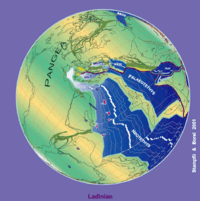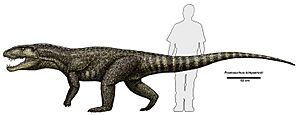Triassic facts for kids
The Triassic was the first period in the Mesozoic Era, which is often called the "Age of Reptiles." It lasted for about 50.6 million years. This important time in Earth's history began 251.9 million years ago and ended 201.3 million years ago.
Before the Triassic came the Permian period, which was the last part of the Paleozoic Era. After the Triassic, the famous Jurassic period began. Many new groups of animals appeared during the Triassic, including the first dinosaurs and the very first mammals.
Contents
Major Extinction Events
The Triassic period started and ended with huge extinction events. An extinction event is when many different types of plants and animals die out at the same time.
The Triassic began right after the biggest extinction event in Earth's history, called the Permian/Triassic extinction event. Scientists are still trying to figure out exactly what caused this massive die-off. They believe many things probably worked together to cause it.
The Triassic period also had other extinction events, but the one at its end was very significant. It was one of the "big five" Phanerozoic ocean extinctions. These events changed life on Earth forever.
Earth's Geology and Climate
Why is it Called the Triassic?
The name 'Triassic' comes from the three main rock layers that formed during this period. "Tri" means "three," so it refers to these three distinct rock layers:
- Red beds: These were formed in dry, desert-like conditions.
- Limestone: This rock was laid down in seas, often over shallow areas near continents.
- Black slate: This formed in places rich with dead plants and animals, like river deltas.
What Was the Climate Like?
The Triassic climate was very different from today's. Imagine a much warmer Earth!
- There was about 80% of the oxygen we have in the air today.
- The air had about six times more carbon dioxide than before the Industrial Revolution. This gas traps heat.
- The Earth's average temperature was about 3 degrees C hotter than it is now.
Pangaea: The Supercontinent
During the Triassic period, Earth's land was not separated into many continents like it is today. Instead, almost all the land was joined together in one giant supercontinent called Pangaea. This name means "all the land." Pangaea was located mostly around the equator.
Pangaea started to slowly break apart during the Triassic, especially towards the end. However, it hadn't fully separated into different continents yet. Because Pangaea was one huge landmass, it had very little shoreline compared to today's many continents. This is why fossils from Triassic ocean life are rare in many parts of the world. For example, in North America, most ocean fossils from this time are found only in a few places in the west.
New Life Forms Emerge
The early part of the Triassic period had much less variety of life than the Permian period before it. It took about 5 million years for the environment to start getting better. As the environment improved, new types of life began to evolve and fill the empty spaces left by the Permian extinction. This fast growth of new species is called adaptive radiation.
This rapid change happened for reptiles on land, fish in the seas, and even insects. It took about 30 million years for Earth to have diverse communities with complex ecology again.
Fish Life
A very important group of bony fish called teleosts first appeared during the Triassic period. Today, teleosts make up over 80% of all fish and 95% of all bony fish! The only other common group of fish are the Chondrichthyes, which include sharks and rays. Rays also first appeared during the Triassic.
Reptile Life
Many new reptile groups appeared during the Triassic. This was probably because there were so many empty ecological niches after the Permian extinction. Some of these new groups died out in the End–Triassic extinction event, but those that survived went on to rule the Earth for the rest of the Mesozoic Era. Some examples of these new reptile groups include:
- Archosaurs: This group includes the ancestors of dinosaurs and crocodiles.
- Pterosaurs: These were the first flying reptiles.
- Ichthyosaurs: These were marine reptiles that looked a bit like dolphins.
- Turtles: The first turtles appeared.
- Plesiosaurs: These were long-necked marine reptiles.
This was a big change because, in the middle of the Triassic, the Synapsids (which were the mammals' ancestors) were still the most common land animals.
The End-Triassic Extinction
Many reptile groups became extinct at the end of the Triassic period. These included:
- Some crocodile-like Archosaurs, such as Ornithosuchids, Aetosaurs, and Rauisuchians.
- Other Archosaurs like Euparkeria and Erythrosuchids.
- Reptiles like Rhyncosaurs and Trilophosaurs.
- The Dicynodonts, which were a type of Synapsid (mammal ancestor), also died out.
The Triassic was a time of huge changes for tetrapods (animals with four limbs). Many important new groups appeared, but many others disappeared. Scientists find it hard to fully explain these events because there are fewer fossils from the Triassic period compared to other times in the Mesozoic Era.
Related pages
Images for kids
-
Large marine predators from the Early Triassic
-
Staurikosaurus eating a dicynodont in the Paleorrota geopark.
-
Cynognathus was a mammal-like cynodont from the Early Triassic. The first true mammals evolved during this period.
-
Plateosaurus was an early long-necked dinosaur, or "prosauropod," from the Late Triassic.
-
Coelophysis, one of the first dinosaurs, appeared in the Late Triassic.
-
A reconstruction of Tanystropheus longobardicus, a reptile with a very long neck.
See also
 In Spanish: Triásico para niños
In Spanish: Triásico para niños












